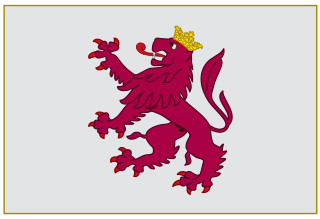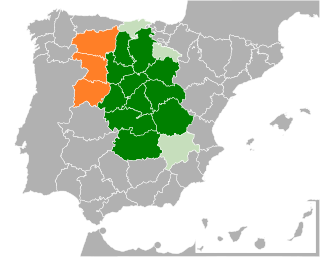
The Iberian Peninsula, also known as Iberia, is a peninsula in south-western Europe. Separated from the rest of the European landmass by the Pyrenees, it includes the territories of Peninsular Spain and Continental Portugal, comprising most of the region, as well as the tiny adjuncts of Andorra, the British Overseas Territory of Gibraltar, and, pursuant to the traditional definition of the Pyrenees as the peninsula's northeastern boundary, a small part of France. With an area of approximately 583,254 square kilometres (225,196 sq mi), and a population of roughly 53 million, it is the second-largest European peninsula by area, after the Scandinavian Peninsula.
Castile or Castille is a territory of imprecise limits located in Spain. The use of the concept of Castile relies on the assimilation of a 19th-century determinist geographical notion, that of Castile as Spain's centro mesetario with a long-gone historical entity of diachronically variable territorial extension.

Castile and León is an autonomous community in northwestern Spain. It was created in 1983 by merging the provinces of the historic region of León: León, Zamora and Salamanca, with those of Old Castile : Ávila, Burgos, Palencia, Segovia, Soria and Valladolid. The provinces of Santander and Logroño, which until then had been included in the "Old Castile" administrative division, opted out of this merger and formed the new Autonomous Communities of Cantabria and La Rioja respectively. Condado de Treviño and La Puebla de Arganzón, the two municipalities that make up the Treviño enclave, are geographically surrounded by the neighboring Basque Country Autonomous Community, but belong to Castile and León.

The Spanish language has two names: español and castellano. Spanish speakers from different countries or backgrounds can show a preference for one term or the other, or use them indiscriminately, but political issues or common usage might lead speakers to prefer one term over the other. This article identifies the differences between those terms, the countries or backgrounds that show a preference for one or the other, and the implications the choice of words might have for a native Spanish speaker.

The Kingdom of León was an independent kingdom situated in the northwest region of the Iberian Peninsula. It was founded in 910 when the Christian princes of Asturias along the northern coast of the peninsula shifted their capital from Oviedo to the city of León. The kings of León fought civil wars, wars against neighbouring kingdoms, and campaigns to repel invasions by both the Moors and the Vikings, all in order to protect their kingdom's changing fortunes.

The Catholic Monarchs were Queen Isabella I of Castile and King Ferdinand II of Aragon, whose marriage and joint rule marked the de facto unification of Spain. They were both from the House of Trastámara and were second cousins, being both descended from John I of Castile; to remove the obstacle that this consanguinity would otherwise have posed to their marriage under canon law, they were given a papal dispensation by Sixtus IV. They married on October 19, 1469, in the city of Valladolid; Isabella was 18 years old and Ferdinand a year younger. Most scholars generally accept that the unification of Spain can essentially be traced back to the marriage of Ferdinand and Isabella. Their reign was called by W.H. Prescott "the most glorious epoch in the annals of Spain".

Andalusi Romance, also called Mozarabic or Ajami, refers to the varieties of Ibero-Romance that developed in Al-Andalus, the parts of the medieval Iberian Peninsula under Islamic control. Romance, or vernacular Late Latin, was the common tongue for the great majority of the Iberian population at the time of the Umayyad conquest in the early eighth century, but over the following centuries, it was gradually superseded by Andalusi Arabic as the main spoken language in the Muslim-controlled south. At the same time, as the northern Christian kingdoms pushed south into Al-Andalus, their respective Romance varieties gained ground at the expense of Andalusi Romance as well as Arabic. The final extinction of the former may be estimated to 1300 CE.

The Kingdom of Aragon was a medieval and early modern kingdom on the Iberian Peninsula, corresponding to the modern-day autonomous community of Aragon, in Spain. It should not be confused with the larger Crown of Aragon, which also included other territories—the Principality of Catalonia, the Kingdom of Valencia, the Kingdom of Majorca, and other possessions that are now part of France, Italy, and Greece—that were also under the rule of the King of Aragon, but were administered separately from the Kingdom of Aragon.
Spanish–Portuguese Wars may refer to one of the following conflicts between Portugal and Spain :

Spaniards, or Spanish people, are a people native to Spain. Within Spain, there are a number of national and regional ethnic identities that reflect the country's complex history, including a number of different languages, both indigenous and local linguistic descendants of the Roman-imposed Latin language, of which Spanish is the largest and the only one that is official throughout the whole country.

Iberism, also known as pan-Iberism or Iberian federalism, is the pan-nationalist ideology supporting a unification of all the territories of the Iberian Peninsula. It mostly encompasses Andorra, Portugal and Spain, but may also include: Gibraltar and territories of France such as Northern Catalonia or the French Basque Country.

The Kingdom of Valencia, located in the eastern shore of the Iberian Peninsula, was one of the component realms of the Crown of Aragon.
Castile, Castille or Castilla may refer to:
In English, Castilian Spanish can mean the variety of Peninsular Spanish spoken in northern and central Spain, the standard form of Spanish, or Spanish from Spain in general. In Spanish, the term castellano (Castilian) can either refer to the Spanish language as a whole, or to the medieval Old Spanish, a predecessor to Early Modern Spanish.

Both the perceived nationhood of Spain, and the perceived distinctions between different parts of its territory derive from historical, geographical, linguistic, economic, political, ethnic and social factors.

Castilians are the inhabitants of the historical region of Castile. However, the region's exact limits are disputed.

The following outline is provided as an overview of and topical guide to Spain:

The Emirate of Granada, also known as the Nasrid Kingdom of Granada, was an Islamic polity in the southern Iberian Peninsula during the Late Middle Ages, ruled by the Nasrid dynasty. It was the last independent Muslim state in Western Europe.

The Region of León, Leonese region or Leonese Country is a historic territory defined by the 1833 Spanish administrative organisation. The Leonese region encompassed the provinces of Salamanca, Zamora, and León, now part of the modern Spanish autonomous community of Castile and León. As is the case with other historical regions, and continuing with centuries of history, the inhabitants of the Leonese region are still called Leonese. Even today, according with official autonomous government, the historical territorial adjective is used in addition with the modern annexed territory, the rest of Old Castile, being "Castilians and Leonese".

The Kingdom of Granada was a territorial jurisdiction of the Crown of Castile from the conclusion of the Reconquista in 1492 until Javier de Burgos' provincial division of Spain in 1833. This was a "kingdom" ("reino") in the second sense given by the Diccionario de la lengua española de la Real Academia Española: the Crown of Castile consisted of several such kingdoms. Its extent is detailed in Gelo del Cabildo's 1751 Respuestas Generales del Catastro de Ensenada (1750–54), which was part of the documentation of a census. Like the other kingdoms within Spain, the Kingdom of Granada was abolished by the 1833 territorial division.















